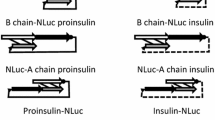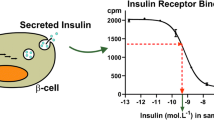Abstract
In the present study our interests focused on the evaluation of a high capacity assay (MEIA) which allows true insulin determinations in the absence of cross-reactivity with proinsulin-like molecules. This method was compared to a commercially available radioimmunoassay (RIA) for insulin determination. As the latter gives insulin levels which represent a mixture of insulin and proinsulin-like molecules, the proinsulin-like molecules were quantitated by subtracting the true insulin levels measured using MEIA from the total insulin levels obtained using RIA. These methods were applied for the analysis of blood samples drawn in 63 normal subjects, 16 obese subjects, 3 patients submitted to islet transplantation and 4 patients with insulinoma. The MEIA was precise, fully automated and time-saving, making its application on a routine basis particularly attractive. MEIA and RIA were equally able to correctly quantify human insulin molecules. On the contrary, the antibody present in the true insulin assay did not interact with proinsulin-like molecules, which were recognized even in the presence of increasing insulin levels. In normal subjects, the true and total insulin levels in the fasting state and at the time peak after glucose-or arginine-induced endogenous insulin release were well correlated atr=0.88 and 0.89, respectively. Interestingly, total insulin values were overestimated by 10%–16% as compared with true insulin levels, which represent proinsulin values superimposable on previously reported data. Proinsulin-like molecules made up 50% of the total insulin in obese and transplanted patients, and about 70% in patients with insulinoma. In conclusion, the present study describes a precise, sensitive, fully automated and time-saving method for true insulin determination which is competitive with previously published methods. By subtracting the immunoreactivity measured in the insulin RIA and the insulin MEIA, we obtained the proinsulin-like molecule levels in the range previously reported for normal and obese subjects and patients with insulinoma, and provided a new insight into islet-transplanted patients.
Similar content being viewed by others
References
Yoshioka M, Tanigychi H, Kawaguchi A, Kobayashi T, Murakami K, Seki M, Tsutou A, Tamagawa M, Minoda H, Baba S, Evaluation of a commercial enzyme immunoassay for insulin in human serum, and its clinical application. Clin Chem 25:35–38, 1979
Kuzuya H, Blix PM, Horwitz DL, Steiner DF, Rubenstein AH, Determination of free and total insulin and C-peptide in insulin-treated diabetics. Diabetes 26:22–29, 1977
Duckworth WC, Kitabchi AE, Heinemann M, Direct measurement of plasma proinsulin in normal and diabetic subjects. Am J Med 53:418–427, 1972
Mako ME, Starr JI, Rubenstein AH, Circulating proinsulin in patients with maturity onset diabetes. Am J Med 63:865–869, 1977
Yoshioka N, Kuzuya T, Matsuda A, Taniguchi M, Iwamoto Y, Serum proinsulin levels at fasting and after oral glucose load in patients with type 2 (non-insulin-dependent) diabetes mellitus. Diabetologia 31:355–360, 1988
Saad MF, Kahn SE, Nelson RG, Pettitt DJ, Knowler WC, Schwartz MW, Kowalyk S, Bennett PH, Porte D, Disproportionately elevated proinsulin in Pima Indians with non-insulindependent diabetes mellitus. J Clin Endocrinol Metab 70:1247–1253, 1990
Deacon CF, Schleser-Mohr S, Ballmann M, Willms B, Conlon JM, Creutzfeldt W, Preferential release of proinsulin relative to insulin in non-insulin-dependent diabetes mellitus. Acta Endocrinol 119:549–554, 1988
Beer SF, Rahilly SO, Spivey RS, Hales CN, Turner RC, Plasma proinsulin in first-degree relatives of type 2 diabetic subjects. Diabetes Res 14:51–54, 1990
Hartling SG, Lindgrend F, Dahlqvist G, Persson B Binder C, Elevated proinsulin in healthy siblings of IDDM patients independent of HLA identity. Diabetes 38:1271–1274, 1989
Heaton DA, Millvard BA, Gray IP, Tun Y, Pyke DA, Leslie RDG, Increased proinsulin levels as an early indicator of B-cell dysfunction in non-diabetic twins of type 1 (insulin-dependent) diabetic patients. Diabetologia 31:182–184, 1988
Lindgren FA, Hartling SG, Persson BE, Roder ME, Snellman K, Binder C, Dahlquist G, Proinsulin levels in newborn siblings of type 1 (insulin-dependent) diabetic children and their mothers. Diabetologia 36:560–563, 1993
Reaven GM, Chen YDI, Hollenbeck CK, Sheu WHH, Ostrega D, Polonsky KS, Plasma insulin, C-peptide, and proinsulin concentrations in obese and nonobese individuals with varying degrees of glucose tolerance. J Clin Endocrinol Metab 76:44–48, 1993
Temple RC, Carrington CA, Luzio SD, Owens DR, Schneider AE, Sobey WJ, Hales NC, Insulin deficiency in non-insulin-dependent diabetes. Lancet I:293–295, 1989
Davis SN, Piatti PM, Monti L, Brown MD, Brach W, Hales CN, Alberti KGMM, Proinsulin and insulin concentrations following intravenous glucose challengers in normal, obese and non-insulin dependent diabetic patients. Metabolism 42:30–35, 1993
Halban PA, Rhodes CJ, Shoelson SE, High-performance liquid chromatography (HPLC): a rapid, flexible and sensitive method for separating islet proinsulin and insulin. Diabetologia 29:893–896, 1986
Linde S, Roder ME, Hartling SG, Binder C, Welinder BS, Separation and quantitation of serum proinsulin and proinsulin intermediates in humans. J Chromatogr 548:371–380, 1991
Tolvonen E, Hemmila I, Marniemi J, Jergensen PN, Zeuthen J, Lovgren T, Two site-resolved immunofluorometric assay of human insulin. Clin Chem 32:637–640, 1986
Sobey WJ, Beer SF, Carrington CA, Clark PMS, Frank BH, Gray IP, Luzio SD, Owens DR, Scheineder AE, Siddle K, Temple RC, Hales CN, Sensitive and specific two-site immunoradiometric assays for human insulin, proinsulin, 65–66 split proinsulins. Biochem J 260:535–541, 1989
Hanning I, Home PD, Alberti KGMM, Measurement of free insulin concentrations: the influence of the timing of extraction of insulin antibodies. Diabetologia 28:831–835, 1985
Andersen L, Dinesen B, Jorgensen PN, Poulsen F, Roder ME, Enzyme immunoassay for intact human insulin in serum or plasma. Clin Chem 39:578–582, 1993
Clark PM, Levy JC, Cox L, Burnett M, Turner RC Hales CN, Immunoradiometric assay of insulin, intact proinsulin and 32–33 split proinsulin and radioimmunoassay of insulin in diettreated type II (non-insulin-dependent) diabetic subjects. Diabetologia 35:469–474, 1992
Leahy JL, Halban PA, Weir GC, Relative hypersecretion of proinsulin in rat model of NIDDM. Diabetes 40:985–989, 1991
Ward WK, La Cava EC, Paquette TL, Beard JC, Wallum BJ, Porte D Jr, Disproportionate elevation of immunoreactive proinsulin in type II (non-insulin-dependent) diabetes mellitus and in experimental insulin resistance. Diabetologia 30:698–702, 1987
Shiraishi I, Iwamoto Y, Kuzuja T, Matsuda A, Kumakura S, Hyperinsulinaemia in obesity is not accompanied by an increase in serum proinsulin/insulin ratio in groups of human subjects with and without glucose intolerance. Diabetologia 34:737–741, 1991
Lazarus NR, Tanese T, Gutman R, Recant L, Synthesis and release of proinsulin and insulin by human insulinoma tissue. J Clin Endocrinol Metab 30:273–281, 1970
Fajans S, Floyd JC Jr, Diagnosis and medical management of insulinomas. Ann Rev Med 30:313–329, 1979
Schein P, DeLellis RA, Kahn CR, Gorden P, Kraft AR, Islet cell tumors: Current concepts and management. Ann Intern Med 79:239–257, 1973
Creutzfeltd W, Arnold R, Creutzfeld C, Deuticke U, Frerichs H, Track NS, Biochemical and morphological investigations of 30 human insulinomas. Diabetologia 9:217–231, 1973
Koivisto VA, Yki-Jarvinen H, Hartling SG, Pelkonen R, The effect of exogenous hyperinsulinemia on proinsulin secretion in normal man, obese subjects and patients with insulinoma. J Clin Endocrinol Metab 63:1117–1120, 1986
Diem P, Abid M, Redmon JB, Sutherland DER, Robertson RP, Systemic venous drainage of pancreas allografts as independent cause of hyperinsulinemia in type I diabetic recipients. Diabetes 39:534–540, 1990
Christiansen E, Andersen HB, Rasmussen K, Christensen NJ, Olgaard K, Kirkegaard P, Tronier D, Volund A, Damsbo P, Burcharth F, Madsbad S, Pancreatic β-cell function and glucose metabolism in human segmental pancreas and kidney transplantation. Am J Physiol 264:E441–E449, 1993
Author information
Authors and Affiliations
Rights and permissions
About this article
Cite this article
Monti, L.D., Sandoli, E.P., Phan, V.C. et al. A sensitive and reliable method for assaying true human insulin without interaction with human proinsulin-like molecules. Acta Diabetol 32, 57–63 (1995). https://doi.org/10.1007/BF00581048
Received:
Accepted:
Issue Date:
DOI: https://doi.org/10.1007/BF00581048




